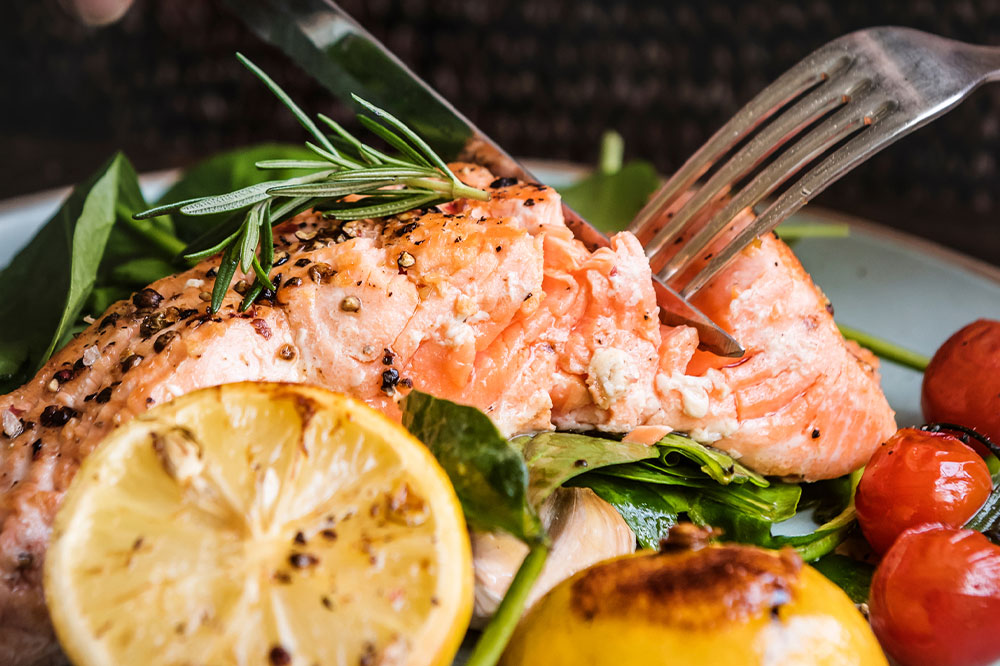10 Healthy Foods That Help Relieve Period Pain

Menstrual cramps are painful sensations that occur before or during a woman’s period. The intensity of such pain can vary among women, causing little discomfort to some while making it excruciating for a few others. The pain in the lower abdomen can be throbs, cramps, and spasms, while it could be a constant dull pain for some. Keep reading to learn more about the causes of menstrual pain and foods to eat to manage them.
Causes of period pain
Uterine contractions
Uterine contractions are the contraction and expansion of the uterine muscle, which happens during the menstrual cycle. Contractions also happen during other times, but most women are unaware of or feel it except during their period and childbirth.
Chemicals and hormonal changes in the uterus
During periods when the muscular wall contracts, it compresses the blood vessels in the uterus lining and cuts off the blood and oxygen supply to the womb. The womb tissues release chemicals to trigger pain. Our body also produces prostaglandins, a chemical that makes the womb muscles contract more, resulting in further pain. Excessive buildup of prostaglandins could lead to stronger contractions and severe pain. The prostaglandins can also cause headaches, diarrhea, and nausea during periods. Too much estrogen can cause the uterine lining to become thick. During a menstrual cycle, the lining breaks down, releasing more prostaglandins and increasing pain.
Underlying conditions
Certain underlying health conditions can also cause period pain for older women. They include-
- Endometriosis – Cells similar to the uterine lining grow outside the uterus.
- Fibroids – They are abnormal growths appearing in the uterine wall that cause severe pain and bleeding during a menstrual cycle.
- Pelvic inflammatory diseases – Infections that affect the upper reproductive organs, namely the uterus and fallopian tubes.
- Adenomyosis – A condition where the endometrial tissue begins to grow in the uterine muscle wall and starts thickening. It can result in an enlarged uterus. When the uterine lining breaks down during the menstrual cycle, it results in excessive bleeding and pain.
Treatment for period pain
Women who experience period pain may have irregular periods, heavy bleeding, lower back pain, foul-smelling vaginal discharge, and pain during intercourse. For women who have started getting their periods, the pain may be there for the first few cycles and will disappear slowly. Period pain may begin a few days before the menstrual cycle and last 2 or 3 days. Some women may experience pain till their menstrual cycle is complete.
Treatment for severe period pain
If the period pain is severe and you notice too heavy or too little bleeding, consult a doctor. They may conduct a pelvic examination to check for any abnormalities. They may also suggest oral prescriptions that can reduce the amount of prostaglandin in the womb. If you are uncomfortable with such prescriptions, they may also recommend alternative options like intrauterine devices to help with period pain.
Treatment for mild period pain
One can use prescription treatments that help relieve pain to manage menstrual cramps. However, always check with a health expert regarding the right dosage. Resting, a warm bath, a compress, breathing exercises, stretching, yoga, and light massage can help relieve mild pain. Eating the right, healthy food before and during the menstrual cycle can also help reduce pain.
Ten foods to manage period pain
During their periods, women might have to deal with losing their appetite, food cravings, nausea, headache, vomiting, etc. Some foods, however, can help prevent inflammation and reduce estrogen levels. One can also eat foods that help reduce water retention and to manage mood swings. Some healthy food choices for dealing with period pain are listed below.
Salmon and cold-water fish
Salmon and generally cold-water fish are rich in omega-3 fatty acids. They have excellent anti-inflammatory properties that help reduce period pain and discomfort.
Eggs
Besides being a super source of protein, eggs are rich in vitamins B6, D, and E, all of which can help fight premenstrual syndrome and pain. However, avoid eggs if you are prone to heartburn and bloating, as eggs can cause gas during periods and add to your pain.
Ginger
Ginger has both pain-relieving and anti-inflammatory properties. Add ground or grated ginger to your gravies, salads, or other dishes. Brew a pot of ginger tea and sip a few mouthfuls throughout the day; it can reduce pain and gas and help you find instant relief.
Leafy green vegetables
Both cruciferous and leafy green vegetables are rich in magnesium and calcium, which are beneficial in managing period pain. One can include vegetables like kale, spinach, and Swiss chard in one’s daily meals.
Dark chocolate
Dark chocolate is high in magnesium, which can help relax the uterine muscle walls. They also contain endorphins which help women relax and help them fight mood swings.
Watermelon
Hormonal changes before and during periods can lead to dehydration. Water-rich food like watermelon or cucumbers can prevent dehydration and excess thirst.
Pineapples
The enzyme bromelain found in pineapple helps uterine muscles relax. The fruit’s anti-inflammatory properties help in reducing period-related pain. Pineapples can help by relieving the dull pain one may experience throughout the menstrual cycle.
Yogurt
Yogurt is rich in calcium and can control pain and bloating, which are expected during periods. If you experience digestion problems during your period, dilute yogurt with water and whisk it until it mixes well. Make a jar of buttermilk and have a cup throughout the day. Yogurt is an excellent source of probiotics that helps people overcome bloating and diarrhea associated with periods.
Oatmeal
Oatmeal contains minerals like magnesium and zinc and is a rich source of fiber and antioxidants. A bowl of oatmeal can help relax the blood vessels, reduce inflammation, and relieve period pain. Magnesium also has pain-relieving properties, while zinc can help reduce inflammation.
Peanut butter
Peanut butter is a favorite food for everyone. Keep a jar of unsalted low-fat peanut butter in your pantry to help you manage period pain. It is rich in magnesium and can help fight period pain. It can also prevent bloating that is normal during the menstrual cycle.
















